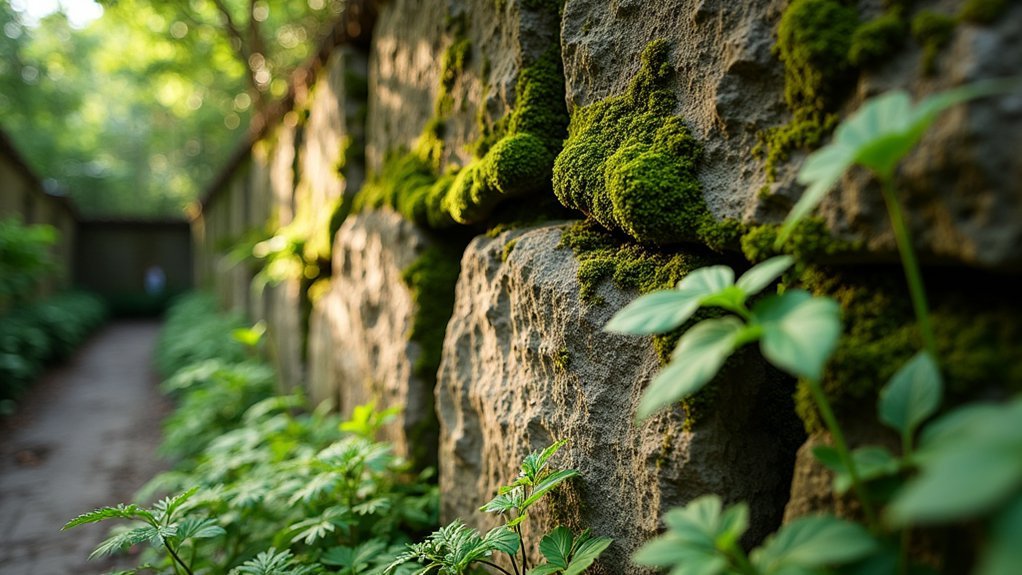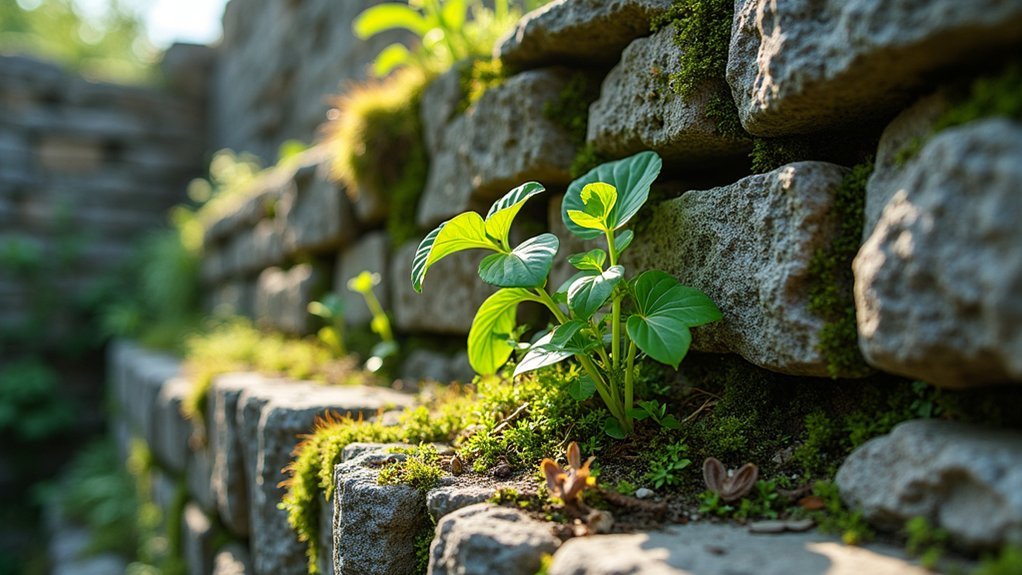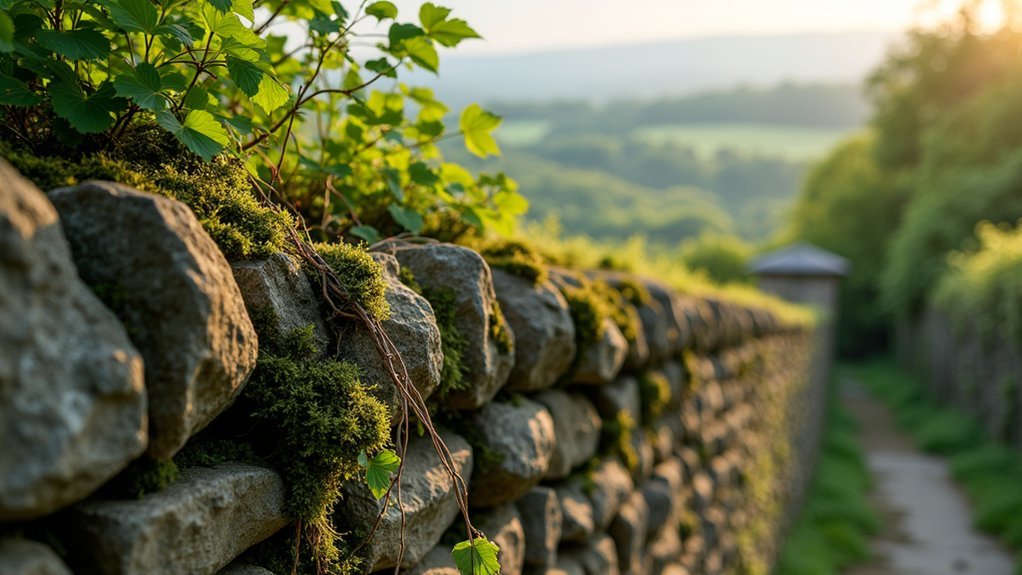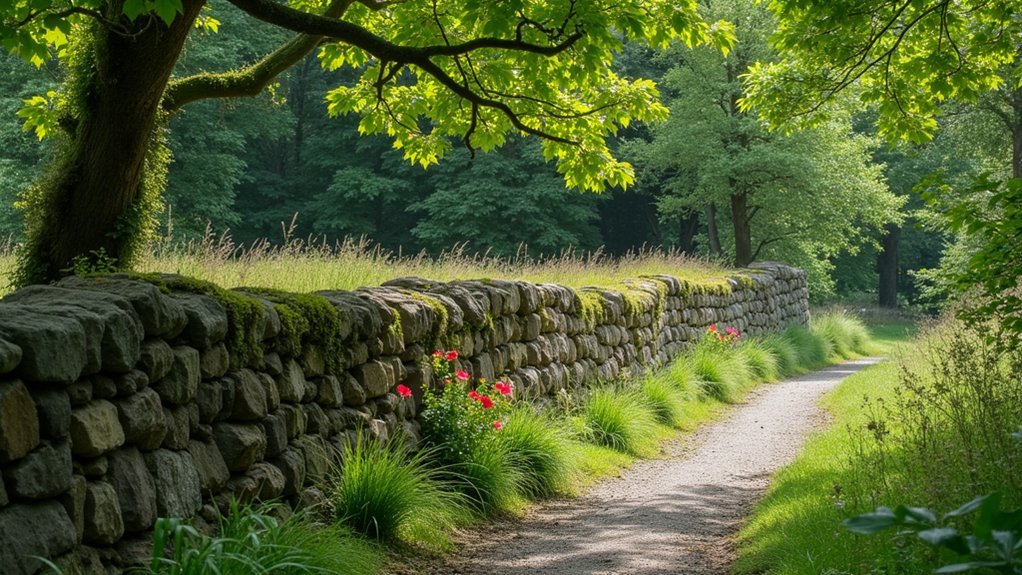Ancient stone-vegetation borders remain relevant today because they serve as biodiversity hotspots, natural water management systems, and cultural artifacts. You’ll find these structures support climate resilience while preserving traditional knowledge about sustainable land management. They create essential wildlife corridors, reduce erosion, and strengthen community connections to the land. Beyond their historical significance, these boundaries offer practical solutions for modern environmental challenges that you can apply to contemporary land stewardship approaches.
The Forgotten Legacy of Stone-Vegetation Boundaries

While modern landscapes often showcase manicured lawns and metal fencing, the ancient stone-vegetation boundaries that once defined our agricultural heritage now lie largely forgotten.
These stone walls represent an extraordinary investment of human labor—approximately 40 million days were required to build them in the Hudson Valley alone by 1871.
You’re walking past living monuments when you encounter these structures. Created by Indigenous peoples and colonial farmers, they served as vital markers for land management and resource allocation.
Today, roughly 120,000 miles of these historic stone walls remain throughout the Hudson Valley and New England, but they face threats from development and farming decline.
When you help preserve these boundaries, you’re not just saving rocks—you’re protecting cultural artifacts that connect you viscerally to centuries of agricultural history.
Ecological Significance of Mixed Border Systems
You’ll discover that mixed stone-vegetation borders create biodiversity hotspots where numerous species thrive in these unique shifting zones.
These ancient systems manage water naturally, capturing rainfall and directing it to areas where it’s most needed while preventing erosion during heavy downpours.
As our climate changes, these border structures form resilience zones that buffer temperature extremes and protect surrounding landscapes from increasingly severe weather patterns.
Biodiversity Hotspot Creation
Despite their modest appearance, ancient stone-vegetation borders represent powerful catalysts for biodiversity, creating ecological hotspots in otherwise homogeneous landscapes.
You’ll find these systems support large quantities of species that thrive in the unique microhabitats formed by the structural complexity of stone walls.
When you explore these borders, you’ll discover:
- Higher species richness compared to surrounding agricultural fields
- Wildlife corridors that enable species migration across fragmented landscapes
- Microhabitats that foster specialized plant and animal communities
These ancient borders don’t just preserve history—they actively contribute to ecosystem resilience as climate change intensifies.
Natural Water Management
As ancient stone-vegetation borders traverse landscapes, they function as sophisticated natural water management systems. These ingenious structures, developed years ago by agricultural communities, work by intercepting and slowing water runoff.
You’ll find that the stone components create natural barriers that redirect water flow, while the vegetation absorbs moisture, reducing erosion and allowing water to penetrate deeper into soil profiles.
In arid regions, you’re witnessing ancient technology at work when these borders retain precious moisture that would otherwise be lost. The microhabitats created between stones and plants enhance water retention capacity, effectively acting as natural reservoirs.
This traditional approach to water management continues to offer sustainable solutions for contemporary challenges, demonstrating how indigenous knowledge can address modern climate adaptation needs without requiring complex infrastructure.
Climate Resilience Zones
Beyond water management, ancient stone-vegetation borders establish remarkable climate resilience zones within landscapes.
These mixed systems, still functioning centuries later, create ecological strongholds that buffer against our changing climate. You’ll find these borders working silently to slow destructive wind patterns while capturing precious moisture during extreme weather events.
These resilience zones offer three key ecological benefits:
- They form microhabitats supporting diverse plant and animal species that might otherwise disappear.
- They strengthen ecosystem immunity against pests and diseases.
- They reduce soil erosion while improving overall landscape health.
Cultural Heritage Preserved in Ancient Boundaries
While modern society often views boundaries as simple dividing lines, ancient stone-vegetation borders stand as remarkable repositories of cultural heritage. When you walk alongside a Roman terminus marker or Hudson Valley stone wall, you’re witnessing the labor of generations—approximately 40 million days of work that shaped agricultural landscapes and preserved communal histories.
| Region | Heritage Element | Cultural Significance |
|---|---|---|
| Roman Empire | Terminus markers | Sacred property boundaries |
| Hudson Valley | Stone field walls | Generational agricultural legacy |
| Global traditions | Boundary rituals | Community identity markers |
| Modern preservation | Conservation efforts | Connection to ancestral land use |
These enduring structures reflect how communities defined themselves through their relationship with the land. The preservation of these ancient boundaries isn’t merely about conserving stones—it’s about maintaining the living cultural heritage that connects you to centuries of human environmental interaction.
Sustainable Design Principles From Historical Borders

When examining the environmental ingenuity of our ancestors, ancient stone-vegetation borders emerge as masterclasses in sustainable design.
These borders exemplify sustainable design principles you can still appreciate today: they utilized locally sourced materials, repurposed glacial stones that would otherwise be obstacles, and required no manufacturing processes.
Ancient sustainable design speaks through stone – naturally sourced, cleverly repurposed, zero manufacturing footprint.
- Resource Efficiency – You’re witnessing the ultimate recycling project when viewing these walls, where farmers turned landscape “waste” into functional infrastructure.
- Minimal Environmental Impact – Unlike modern fencing, these boundaries create habitats rather than disrupt ecosystems.
- Community-Centered Construction – The collective labor approach fostered stronger connections to land and resources.
Indigenous Knowledge in Boundary Creation
The wisdom of Indigenous peoples permeates ancient stone-vegetation borders across continents, revealing sophisticated knowledge systems that modern land management often overlooks. For thousands of years, Indigenous communities constructed stone walls and markers that respected natural landscapes while establishing territorial boundaries and resource management systems.
You’ll find these Ceremonial Stone Landscapes throughout North America, where they embody not just physical borders but connections between cultural practices and spiritual beliefs. These structures weren’t simply dividing lines—they represented communal labor and collective stewardship principles.
When you examine Indigenous boundary creation, you’re witnessing a sophisticated integration of ecological understanding with social organization.
Today’s environmental conservation efforts increasingly recognize the value of these traditional approaches, acknowledging that practices sustained over countless years contain essential wisdom worth preserving and implementing in contemporary land management.
Climate Resilience of Stone-Plant Combinations

Ancient stone-vegetation borders demonstrate remarkable resilience against climate challenges, offering lessons for our warming world.
These traditional boundaries combine stone’s durability with vegetation’s adaptability to create systems that naturally combat climate stressors.
You’ll find these stone-plant combinations enhance climate resilience through:
- Soil protection – The structures prevent erosion while maintaining nutrient-rich soil that sustains plant growth even during extreme weather events.
- Water management – Stone borders slow runoff, increasing water infiltration and availability during droughts.
- Carbon capture – The stabilized soil environment promotes robust plant growth that sequesters atmospheric carbon.
When you protect these ancient boundaries, you’re not just preserving history—you’re championing time-tested climate resilience strategies that communities have relied on for centuries, offering sustainable solutions for our climate-challenged future.
Wildlife Habitats Along Traditional Boundaries
Stone walls stretching across the landscape serve as more than mere property markers—they’re thriving ecosystems that support diverse wildlife populations.
When you explore the Hudson Valley or New England, you’ll find approximately 120,000 miles of these structures creating essential wildlife habitats.
These colonial-era boundaries form microhabitats where smaller creatures find shelter and nesting sites, while simultaneously acting as ecological corridors that facilitate wildlife movement.
The walls’ nooks and crannies offer protection for various species, enhancing biodiversity and maintaining ecological balance.
As nature gradually reclaims abandoned walls, you’re witnessing a living representation of human-nature interconnection.
The estimated 40 million days of labor invested in these structures has inadvertently created complex habitats that continue to support regional flora and fauna—a legacy worth preserving.
The Craftsmanship Behind Enduring Borders

Hidden beneath each carefully placed stone lies a story of immense human effort and ingenuity that shaped the American landscape for centuries.
Stone walls whisper the forgotten tales of determination and skill that transformed American soil into a tapestry of human persistence.
The craftsmanship evidenced in these ancient structures is staggering—252,539 miles of stone walls across New England required an estimated 40 million days of labor by 1871 in the Hudson Valley alone.
You’ll appreciate these enduring borders more when you understand:
- Farmers, their families, and enslaved individuals worked together to move massive quantities of stone
- Each wall served practical purposes—containing livestock and organizing agricultural fields
- The intricate dry-stacking technique allowed walls to withstand centuries of harsh weather without mortar
Today, initiatives like the Stone Wall Initiative work to preserve these masterpieces of rural craftsmanship, ensuring future generations can witness this remarkable symbol of American determination.
Regional Variations in Stone-Vegetation Techniques
As you travel across American regions, the extraordinary stone-vegetation borders you’ll encounter showcase distinctive regional characteristics that reflect each area’s unique geological history, agricultural practices, and cultural influences.
In the Hudson Valley, stone walls evolved from Indigenous constructions to colonial adaptations that addressed the constant challenge of frost-heaved stones. You’ll notice regional functionality differences in these remarkable structures:
| Region | Purpose | Design Features |
|---|---|---|
| Hudson Valley | Glacial stone management | Linear landfills with integrated vegetation |
| New England | Livestock containment | Higher, more structured walls |
| Northeastern NY | Agricultural organization | Field-dividing patterns |
Modern Applications of Ancient Border Methods

While generations have passed since their original construction, the ingenious stone-vegetation borders created by early Americans offer valuable lessons for today’s land management challenges.
You can implement these time-tested techniques in your modern applications to create sustainable solutions that honor our agricultural heritage.
- Resource optimization – Use local materials at your construction site to reduce transportation costs and carbon footprint, just as early farmers utilized stones cleared from their fields.
- Community engagement – Organize volunteer restoration projects that build community bonds while preserving historical landmarks.
- Sustainable design – Incorporate traditional stone wall construction methods into contemporary landscape design for boundaries that withstand weathering and require minimal maintenance.
These ancient practices aren’t merely historical curiosities—they’re practical solutions for today’s environmental and agricultural challenges that can transform how you manage your land.
Healing the Landscape Through Traditional Boundaries
You’ll find that ancient stone walls function as more than mere boundaries—they’re essential ecological corridors that facilitate native species movement and habitat diversity.
When you restore these traditional stone-vegetation borders, you’re actively participating in landscape healing by reestablishing ecological balances that modern development has disrupted.
These time-tested boundaries also incorporate erosion control wisdom from earlier generations, demonstrating how Indigenous and colonial land management practices can address contemporary environmental challenges.
Ecological Balance Restoration
The ancient practice of constructing stone-vegetation borders serves as nature’s unsung hero in landscape restoration efforts today.
You’ll find these seemingly simple structures actively restoring ecological balance by preventing soil erosion while creating microhabitats that foster biodiversity.
When you incorporate these traditional boundaries in your landscape, you’re not just preserving history—you’re enabling natural regeneration processes that modern interventions often fail to achieve.
- Stone walls enhance water retention, helping your soil stay moist even during dry periods.
- They provide essential shelter for beneficial insects, small mammals, and native plant species.
- By defining distinct ecological zones, they prevent invasive species from overtaking vulnerable native vegetation.
These living boundaries connect our agricultural heritage with contemporary conservation needs, demonstrating how ancient wisdom continues to heal our modern landscapes.
Native Species Preservation
Three distinct ecosystems thrive along traditional stone-vegetation borders, creating critical sanctuaries for native species increasingly threatened by habitat loss.
These colonial-era walls serve as microhabitats where you’ll find specialized plants growing in crevices, small mammals seeking shelter, and reptiles basking on sun-warmed stones.
When you preserve these historic boundaries, you’re not just honoring the Hudson Valley’s cultural heritage but actively contributing to native species preservation.
The Stone Wall Initiative has documented how these structures support biodiversity by connecting fragmented habitats across developed landscapes.
You’re participating in ecological healing each time you maintain or restore these walls.
Erosion Control Wisdom
While most visitors admire stone walls for their rustic charm, these ancient boundaries actually serve as sophisticated erosion control systems developed through centuries of agricultural wisdom.
Colonial farmers in the Hudson Valley transformed glacial stone abundance into functional structures that stabilize soil and prevent harmful runoff.
These walls continue to protect our landscapes through:
- Soil stabilization – reducing downslope movement during heavy rains
- Water flow management – creating natural barriers that slow runoff
- Microhabitat formation – supporting biodiversity that strengthens soil structure
You’re witnessing living erosion control technology when you encounter these structures.
The community-built walls represent traditional ecological knowledge that modern sustainability practices are only beginning to rediscover.
Their preservation guarantees both cultural continuity and continued landscape healing through time-tested methods.
Economic Benefits of Reviving Stone-Plant Borders
As communities across the world seek sustainable development solutions, reviving ancient stone-vegetation borders offers compelling economic advantages beyond their historical significance.
You’ll find these structures boost agricultural productivity through improved soil quality and reduced erosion, ultimately increasing crop yields while decreasing dependence on costly fertilizers.
The economic benefits extend to tourism revenue, as these restored landscapes attract visitors fascinated by cultural heritage and natural beauty.
You’re also saving money on pest management when these borders create natural wildlife barriers, protecting your crops without chemical expenses.
The restoration process itself generates local employment opportunities, preserving traditional skills while stimulating community economies.
Additionally, the enhanced biodiversity these borders support improves ecosystem services like pollination, creating a virtuous cycle that strengthens agricultural production and economic resilience.
Community Engagement in Boundary Restoration
Because preservation efforts flourish when communities actively participate, successful stone-vegetation border restoration projects prioritize local involvement at every stage.
You’ll find vibrant community engagement through volunteer programs like the Stone Wall Initiative in New England, where residents connect with their cultural heritage while restoring ancient boundaries.
Your participation matters in three key ways:
- Educational workshops teach you about the historical significance of stone walls, strengthening your connection to local history.
- Collaborative restoration days allow you to work alongside historians and preservationists, learning traditional techniques.
- Youth involvement opportunities create intergenerational knowledge transfer while instilling environmental stewardship in younger community members.
Frequently Asked Questions
How Do Property Laws Affect Ancient Boundary Maintenance?
Property laws can limit your ability to maintain ancient boundaries if you don’t own them. You’ll need to check local regulations and historical preservation laws before modifying these structures on your property.
Can Ancient Borders Be Protected Under UNESCO Heritage Status?
Yes, you can seek UNESCO World Heritage status for ancient borders if they’ve got outstanding universal value. They’ll need to meet specific criteria demonstrating cultural significance and have adequate protection measures in place.
What Tools Were Historically Used to Construct These Borders?
You’ll find that basic tools like stone hammers, wooden mallets, and metal chisels were historically used to construct these borders. Farmers also used simple digging sticks and wooden rakes to arrange vegetation boundaries.
How Do Seasonal Changes Affect Stone-Vegetation Border Appearance?
You’ll notice stone borders remain constant while vegetation transforms seasonally. In spring, borders frame lush growth; summer showcases full contrast; fall brings color drama; winter reveals the stark stone structure underneath.
Are There Religious or Spiritual Aspects to Traditional Boundaries?
Yes, you’ll find many religious traditions imbue boundaries with spiritual significance. They’re often seen as sacred thresholds, places of protection, or markers where divine agreements were established within traditional belief systems.
In Summary
You’ve discovered what our ancestors knew all along—these borders aren’t just relics but living solutions. When you incorporate stone-vegetation boundaries into modern landscapes, you’re preserving biodiversity, honoring cultural heritage, and practicing sustainable design. As you reconnect with these ancient techniques, you’re not just restoring physical boundaries but rebuilding your relationship with the land while creating resilient, beautiful spaces that benefit both community and environment.





Leave a Reply